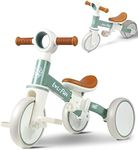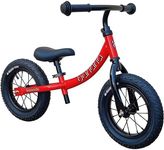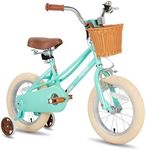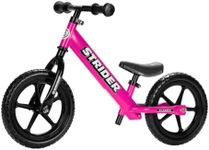Buying Guide for the Best Bike For 3 Year Olds
Choosing a bike for a 3-year-old is an exciting task that can help foster a love for cycling and outdoor activities. At this age, children are developing their balance and coordination skills, so it's important to select a bike that is safe, comfortable, and suitable for their size and abilities. The right bike can provide a sense of independence and confidence as they learn to ride. When selecting a bike, consider the child's height, weight, and level of physical development to ensure a good fit. Additionally, think about where the bike will be used most often, such as on sidewalks, in parks, or on trails, as this can influence the type of bike you choose.Bike SizeBike size is crucial because it affects the child's ability to control the bike and ride safely. For 3-year-olds, bikes typically come with 12-inch wheels, which are suitable for their height and leg length. It's important to ensure that the child can comfortably reach the ground with their feet while sitting on the seat, as this helps them stop and balance easily. To pick the right size, have the child sit on the bike and check if they can touch the ground with their toes or flat feet. If they can, the bike is likely a good fit.
Weight of the BikeThe weight of the bike is important because a lighter bike is easier for a young child to handle and maneuver. A heavy bike can be difficult for a 3-year-old to control, especially when starting and stopping. Generally, a bike should not weigh more than 30% of the child's body weight. When choosing a bike, look for models made from lightweight materials like aluminum, which are easier for children to manage. Consider how easily the child can lift and push the bike, as this will affect their ability to ride confidently.
BrakesBrakes are essential for safety, allowing the child to stop the bike when needed. For 3-year-olds, coaster brakes (pedal brakes) are often recommended because they are simple to use—children just need to pedal backward to stop. Hand brakes can be more challenging for young children to operate due to their developing hand strength and coordination. When selecting a bike, consider the child's ability to use the brakes effectively. If they are new to biking, coaster brakes might be the best option.
Training WheelsTraining wheels provide stability and help children learn to balance while riding. They are a common feature on bikes for 3-year-olds, as they offer support and build confidence. However, some children may prefer balance bikes, which do not have pedals or training wheels and help develop balance skills naturally. When deciding whether to choose a bike with training wheels, consider the child's current balance skills and confidence level. If they are just starting out, training wheels can be a helpful tool.
AdjustabilityAdjustability refers to the ability to change the height of the seat and handlebars to accommodate the child's growth. This feature is important because it allows the bike to be used for a longer period as the child grows. Look for bikes with easily adjustable seats and handlebars, which can be modified without the need for special tools. When choosing a bike, consider how quickly your child is growing and whether the bike can be adjusted to fit them over time.
Safety FeaturesSafety features are critical to ensure the child's well-being while riding. These can include features like a chain guard to prevent clothing from getting caught, non-slip pedals, and a sturdy frame. Reflectors and a bell can also enhance safety by making the bike more visible and allowing the child to alert others of their presence. When selecting a bike, prioritize models that include these safety features to provide peace of mind while your child is riding.



















